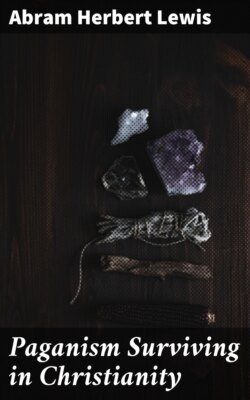Читать книгу Paganism Surviving in Christianity - Abram Herbert Lewis - Страница 9
На сайте Литреса книга снята с продажи.
The Fathers as Allegorists.
ОглавлениеTable of Contents
Beginning with Justin, the leaders of thought in the Church, from the middle of the second century, were men who had been brought up as pagan philosophers, or educated under pagan influence. It was therefore unavoidable that this corrupting system of exegesis should be applied to the books of the New Testament. This was done by the Gnostics, according to their theory that the true meaning of all writings was hidden. Christ’s life presented many difficulties to the philosophers. To explain its seeming contradiction, they resolved the mission of Christ into a series of superhuman movements, and the New Testament into a sort of hieroglyphic record of those movements. Instance: Simeon, taking the young Christ in his arms in the temple,
“was a type of the Demiurge, who, on the arrival of the Saviour, learned his own change of place, and gave thanks to Bythus. They also assert that by Anna, who is spoken of in the Gospel as a prophetess, and who, after living seven years with her husband, passed all the rest of her life in widowhood until she saw the Saviour, and recognized Him, and spoke of Him to all, was most plainly indicated Achamoth, who, having for a little while looked upon the Saviour with his associates, and dwelling all the rest of the time in the intermediate place, waited for Him till He should come again and restore her to her proper consort. Her name, too, was indicated by the Saviour when he said, ‘Yet wisdom is justified by her children.’ This, too, was done by Paul in these words, ‘But we speak wisdom among them that are perfect.’ They declare also that Paul has referred to the conjunctions within the Pleroma, showing them forth by means of one; for, when writing of the conjugal union in this life, he expressed himself thus: ‘This is a great mystery, but I speak concerning Christ and the Church.’ ”[41]
Another instance is found in the interpretation which they made of the raising of Jairus’ daughter:
“They maintain further, that that girl of twelve years old, the daughter of the ruler of the synagogue, whom the Lord approached and raised from the dead, was a type of Achamoth, to whom their Christ, by extending himself, imparted shape, and whom he led anew to the perception of that light which had forsaken her. And that the Saviour appeared to her when she lay outside of the Pleroma as a kind of abortion, they affirm Paul to have declared in his Epistle to the Corinthians (in these words): ‘And last of all, He appeared to me also, as to one born out of due time.’ Again, the coming of the Saviour with His attendants, to Achamoth is declared in like manner by him in the same epistle, when he says: ‘A woman ought to have a veil upon her head, because of the angels.’ Now that Achamoth, when the Saviour came to her, drew a veil over herself through modesty, Moses rendered manifest when he put a veil upon his face. Then, also, they say that the passions which she endured were indicated by the Lord upon the cross. Thus, when He said, ‘My God, my God, why hast thou forsaken me?’ he simply showed that Sophia was deserted by the light, and was restrained by Horos from making any advance forward. Her anguish again was indicated when He said, ‘My soul is exceeding sorrowful, even unto death’; her fear by the words, ‘Father, if it be possible, let this cup pass from me’; and her perplexity, too, when He said, ‘And what I shall say, I know not.’ ”[42]
